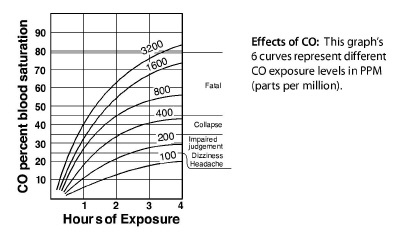
Carbon monoxide is a colorless, odorless, poisonous gas. The two common terms for expressing measured CO concentration are these.
1. “as measured” which compares CO molecules to air molecules in parts per million (ppm).
2. “air free”, which is a value, calculated from the as measured CO and the measured oxygen in combustion gases. Air free denotes what the CO concentration would be in an air-free sample of combustion gases.
The EPA’s suggested maximum 8-hour CO exposure is 9 ppm as measured in room air. Malfunctioning combustion appliances, cigarette smoking, or auto exhaust are the most common CO sources. The EPA’s one-hour CO limit is 35 ppm as measured.

1.3.1 Causes of Carbon Monoxide (CO)
CO is released by unvented gas space heaters, gas-fired domestic water heaters, kerosene space heaters, backdrafting vented space heaters, gas ranges, leaky wood stoves, and motor vehicles idling near the building. Central furnaces and boilers that backdraft may also lead to high levels of CO.
The following conditions cause CO.
• A combustion appliance is overfired compared to its rated fuel input.
• Backdrafting combustion gases smother the flame.
• An object interferes with the flame (a pan over a gas burner on a range top, for example).
• Too-little combustion air.
• Rapidly moving air interferes with the flame.
• Burner misalignment causes a distorted flame.
• Flue or heat exchanger blockage interferes with the flow of flue gases.
Measure CO at the exhaust port of the heat exchanger. Identify and correct CO problems.
Testing for Carbon Monoxide (CO)
The most common CO-test instruments use electronic sensors with a digital display showing parts per million (ppm). Read the manufacturer’s instructions on zeroing the meter — usually by calibrating the meter in outdoor air. CO test equipment must usually be re-calibrated every 6 months, using factory-specified procedures.
Air-free CO measurement includes both CO and O2 sensing with a calculation to find the CO concentration in undiluted flue gases that contain no oxygen. Air-free CO measurement avoids the perception that moving the testing probe or diluting CO are solutions to elevated levels of CO. See "Carbon Monoxide (CO) Testing" on page 256.
Technicians must test for CO both before and after weatherization.